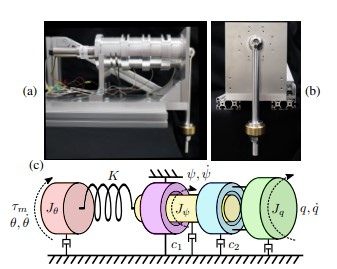Edmundo Pozo Fortunić, Mehmet C. Yildirim, Dennis Ossadnik, Abdalla Swikir, Saeed Abdolshah, and Sami Haddadin
IEEE Robotics and Automation Letters

Abstract
Elastic actuation taps into elastic elements’ energy storage for dynamic motions beyond rigid actuation. While Series Elastic Actuators (SEA) and Variable Stiffness Actuators (VSA) are highly sophisticated, they do not fully provide control
over energy transfer timing. To overcome this problem on the basic system level, the Bi-Stiffness Actuation (BSA) concept was recently proposed. Theoretically, it allows for full link decoupling, while simultaneously being able to lock the spring in the drive train via a switch-and-hold mechanism. Thus, the user would be in full control of the potential energy storage and release timing. In this work, we introduce an initial proof-of-concept of Bi-Stiffness-Actuation, which is implemented using a modular testbed. We present a hybrid system model, as well as the mechatronic implementation of the actuator. We corroborate the feasibility of the concept by conducting a series of hardware
experiments using an open-loop control signal obtained by trajectory optimization. Here, we compare the performance of the prototype with a comparable SEA implementation. We show that BSA outperforms SEA 1) in terms of maximum velocity at low final times and 2) in terms of the movement strategy itself: The clutch mechanism allows the BSA to generate consistent launch sequences, while the SEA has to rely on lengthy and possibly dangerous oscillatory swing-up motions. Furthermore, we demonstrate that providing full control authority over the energy transfer timing and link decoupling allows the user to synchronously release both elastic joint and gravitational
energy. This facilitates the optimal exploitation of elastic and gravitational potentials in a synergistic manner.
@ARTICLE{10287538,
author={Fortunić, Edmundo Pozo and Yildirim, Mehmet C. and Ossadnik, Dennis and Swikir, Abdalla and Abdolshah, Saeed and Haddadin, Sami},
journal={IEEE Robotics and Automation Letters},
title={Optimally Controlling the Timing of Energy Transfer in Elastic Joints: Experimental Validation of the Bi-Stiffness Actuation Concept},
year={2023},
volume={},
number={},
pages={1-8},
doi={10.1109/LRA.2023.3325782}}

